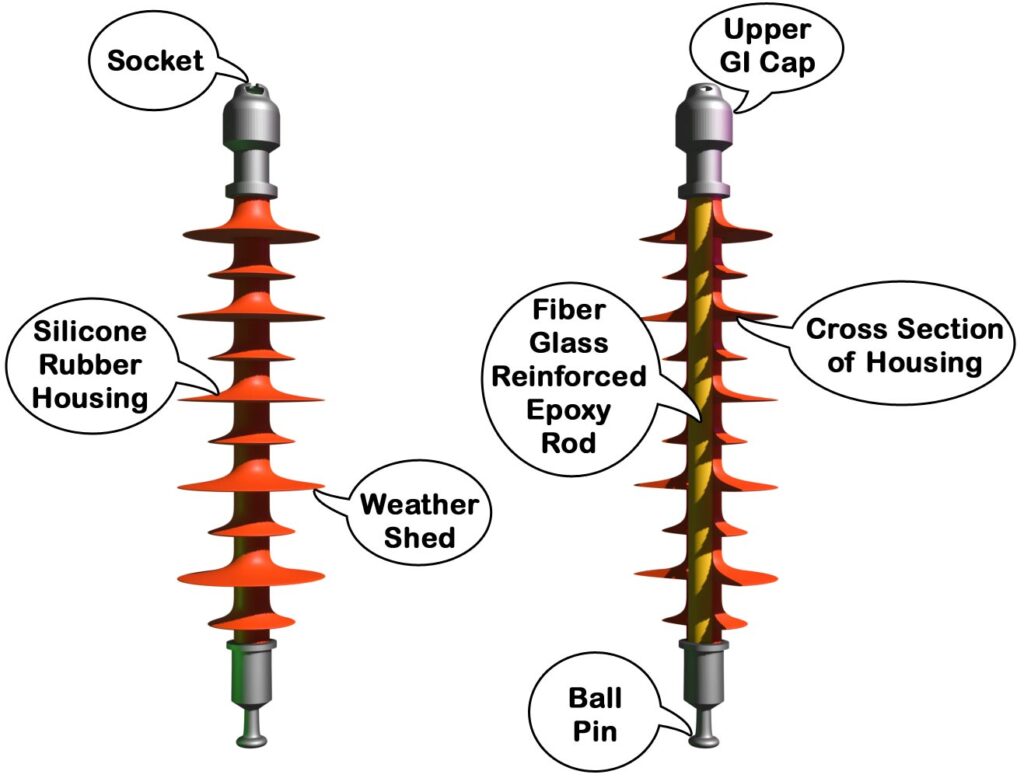Engineers prefer to use silicone rubber composite insulators for transmission lines in areas with high pollution levels. In other words, these areas are among the most heavily polluted. These insulators normally have a creepage distance of 31 mm/ kV. The disc insulators used in heavily polluted areas also have a creepage distance of 31 mm/kV.
Basic Construction of Silicone Rubber Composite Insulators
Silicone rubber composite insulators used in transmission lines are long rod-type insulators. A glass fiber-reinforced epoxy resin rod acts as the core of the insulator. Hence, it provides the required reinforcement to the insulator structure. This means the glass fiber offers mechanical strength, while the resin holds the glass fibers together. In other words, hardened epoxy resin embeds the glass fiber inside it to combine high strength with durability. So, the bond between the resin matrix and glass fiber should be very strong.
Parts of Silicone Rubber Composite Insulators
This type of insulator has two main parts: the central core and the outer layer of silicone rubber with rain sheds or weather shades. We carefully select both the glass fiber and epoxy resin to ensure the best possible performance. The glass fiber must have very low alkali content. Because alkali can weaken glass over time. It must also be boron-free. Generally, the manufacturers use two types of glass for this purpose:
- E-glass – electrical grade glass without boron
- ECR-glass – electrical corrosion-resistant glass, also without boron.
The boron-free structure ensures better corrosion resistance in outdoor environments with high electrical stress.
The epoxy resin matrix must be hydrolysis-resistant. That means it should not participate in hydrolysis. Because hydrolysis degrades when exposed to moisture. The epoxy rod should not have any internal voids, such as air bubbles or gaps, to avoid partial discharge and maintain mechanical strength. During manufacturing, glass fibers are pulled through resin and then through a heated die to form a solid, uniform rod.
Housing of Silicone Rubber Composite Insulators
The fiberglass-reinforced epoxy rod is the core of a silicone rubber composite insulator. A silicone rubber compound sheath with the required number of weather sheds covers the central fiberglass-reinforced epoxy rod. This outer housing, with rain sheds or weather sheds, shields the central insulation core from external environmental effects like UV radiation, temperature changes, and more. It also protects the core from chemicals, salts, industrial contaminants, and other pollutants. Additionally, it prevents water or moisture from entering the central core of the silicon rubber composite insulator.

The umbrella-like projected sheds on the housing help keep certain portions of the insulator dry during rain. The material used for the housing is silicon rubber. The silicon content in the rubber improves hydrophobicity, meaning it enhances water-repelling ability. Water cannot stick to silicon rubber.
Basic Manufacturing Process
There are mainly two techniques that the manufacturers use to form silicon rubber weather sheds
- Silicon rubber forcefully goes through a die to form a housing around the core. This is the extrusion process.
- Silicon rubber is shaped and cured directly onto the fiberglass epoxy rod.
In either case, the interface between the silicon rubber housing and the fiberglass reinforced epoxy rod must be uniform and void-free. Fiber-reinforced plastic, or FRP, is the common name for glass fiber-reinforced resin rods. There is a metal cap on both ends of this resin rod. The cap consists of a socket on one side. Whereas, the end cap of the other end consists of a ball pin.
The manufacturers must mount the metal end caps on the ends of the FRP rod using a uniform crimping method. The crimping and installation method must ensure that under all mechanical loading conditions, these metal fittings do not come off the rod. However, we will not discuss the details of these fittings here, as they fall outside the scope of this article.
Video on Long Rod Silicone Rubber Composite Insulators
